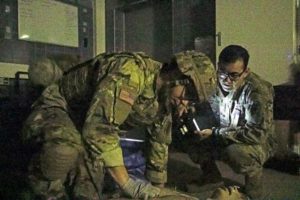
Charged with preserving life on and off the battlefield, combat medics play a vital role in military operations and must be proficient in their practice to save lives.
To keep their skills fresh, combat medics attend the Army’s Medical Education and Demonstration of Individual Competence training at least once every two years. The MEDIC training validates combat medic skills and demonstrates their proficiency in trauma care, airway management, medications, evacuation, CPR, and OB-GYN and pediatric treatment.
“(MEDIC training) keeps them up to date (with certification) as well as demonstrates best practices,” said U.S. Army Sgt. Ryan Williams, a combat medic and instructor at LRMC’s Education Division. “We host Soldiers from all of our outlying clinics (including Army clinics in Italy and Belgium). We have (service members) who are forward-deployed to Afghanistan, (and) Kuwait, and they come over so they can maintain their EMT certifications.”
Combat medics are Soldiers with basic emergency medical technician training, enabling them to provide basic life support functions and trauma care. Although these Soldiers do attend an intensive 16-week training program following basic training, the MEDIC program introduces latest best practices to Soldiers. New procedures and modalities, such as using ketamine versus morphine for acute pain, and injectable medicines to aid blood clotting on the battlefield, require medics to familiarize themselves with to modernize developments in combat medicine.
“The training included specialists coming in to teach extra (patient care practices) we don’t actually learn in (Advanced Individual Training),” said U.S. Army Spc. Jessie Despirito, a combat medic with 1st Infantry Division Forward, and native of West Pelzer, South Carolina. “The training introduced us to orthopedic techniques and physical therapy (among other medical specialties), and since musculoskeletal injuries is the top injury in the Army, it was great.”
Despirito is one of many medics who travel to LRMC for the training while deployed, with the program open to not only whoever requires the training, but even those who want to improve their battlefield medicine capabilities.
“We welcome anybody that wants to come in and get the knowledge,” said Williams, a native of Springfield, Vermont. “It’s a higher level of EMT training, because if I go down (as a casualty) I hope there’s someone who has this training to provide aid.”
The program’s culminating event, a combat scenario where simulated casualties are assessed, treated and evacuated, further tests participants’ ability to operate under pressure, stress and in austere environments.
“First of all, it was very informative, but unlike other classes I’ve done we could actually get hands-on,” said U.S. Army Sgt. Timothy Grier, also a combat medic with 1ID (FWD), and native of Wichita, Kansas. “The fact that we could get hands-on training and then (do) the actual combat casualty assessment, they put a lot of effort into intensifying the training with (environmental stressors).”
The 1st Infantry Division Forward, currently based out of Poznan, Poland, is just one of the units priming combat medics by utilizing the monthly training as they conduct military operations overseas.
“As medics, we just don’t get trained (to this degree) during initial training,” said Grier. “But, you know, the more hands on the better (training).”


